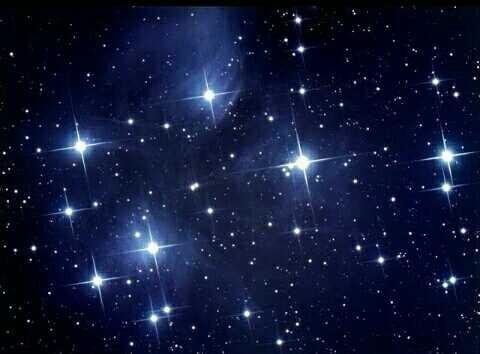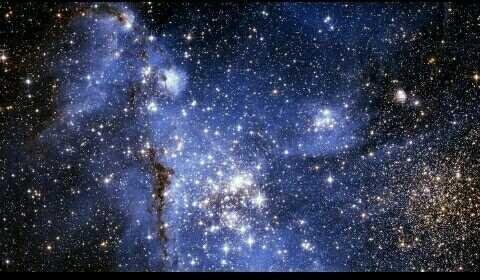My brother is the purpose of the stars

Stars are celestial bodies that emit light. There are pseudo stars and real stars. Fake stars are stars that do not produce their own light, but reflect light received from other stars. The real star is the star that produce their own light. In general the name of a star is an object of outer space that produces its own light (the real star). According to the science of astronomy, the definition of stars is: "All massive objects (mass between 0.08 and 200 solar mass) that are and have ever carried out the generation of energy through nuclear fusion reactions. "Therefore white dwarfs and neutron stars that do not emit light or energy are still called stars. The closest star to Earth is the Sun at a distance of about 149,680,000 kilometers, followed by Proxima Centauri in constellation Centaurus is about four light years away. Observational history The stars have become part of every culture. Stars are used in religious practices, in navigation, and in cultivation. The Gregorian calendar, used in almost every part of the world, is the Sun calendar, basing itself on the Earth's position relative to the nearest star, the Sun. Early astronomers such as Tycho Brahe recognized the 'new stars' in the sky (later novae) indicating that the sky is not eternal. In 1584 Giordano Bruno proposed that the stars were actually other Suns, and might have planets like Earth in their orbit, [1] ideas that had been proposed earlier by ancient Greek philosophers such as Democritus and Epicurus. ] In the next century, the idea that stars are the Sun is far reaching consensus among astronomers. To explain why these stars did not give the gravitational pull of the solar system, Isaac Newton proposed that the stars were evenly distributed throughout the sky, an idea derived from the theologian Richard Bentley. [3] The Italian astronomer Geminiano Montanari recorded a change of luminosity to the Algol star in 1667. Edmond Halley published the first measurements of the motion of a pair of "fixed" stars closely, showing that they changed positions from the time measured by Ptolemaeus and Hipparchus. A direct measurement of 61 Cygni star distance was performed in 1838 by Friedrich Bessel using a parallax technique. William Herschel was the first astronomer to try to determine the distribution of stars in the sky. During the 1780s he enumerated around 600 different sky areas. He then concluded that the number of stars increases steadily to a direction of the sky, ie the center of the Milky Way galaxy. His son John Herschel repeated the same work in the southern sky hemisphere and found the same result. [4] In addition William Herschel also found that some pairs of stars are not the stars that happen to be in one direction the line of sight, but they are physically paired form a double star system

Stars are celestial bodies that emit light. There are pseudo stars and real stars. Fake stars are stars that do not produce their own light, but reflect light received from other stars. The real star is the star that produce their own light. In general the name of a star is an object of outer space that produces its own light (the real star). According to the science of astronomy, the definition of a star is: "All massive objects (mass between 0.08 and 200 solar masses) that are and have ever carried out the generation of energy through nuclear fusion reactions." Therefore, white dwarfs and neutron stars that have not emitted light or energy remain to be called stars. The closest star to Earth is the Sun at a distance of about 149,680,000 kilometers, followed by Proxima Centauri in constellation Centaurus is about four light years away. HISTORY OF OBSERVATIONS The stars have become part of every culture. Stars are used in religious practices, in navigation, and in cultivation. The Gregorian calendar, used in almost every part of the world, is the solar calendar, basing itself on the Earth's position relative to the nearest star, the Sun. Early astronomers such as Tycho Brahe recognized the 'new stars' in the sky (later novae) indicating that the sky is not eternal. In 1584 Giordano Bruno proposed that the stars were actually other suns, and might have planets like Earth in their orbits, ideas that had been suggested earlier by ancient Greek philosophers such as Democritus and Epicurus. In the next century, the idea that stars are the sun that reaches far reaching consensus among astronomers. To explain why these stars do not provide the gravitational pull on the solar system, Isaac Newton proposes that the stars are distributed evenly throughout the sky, an idea derived from the theologian Richard Bentley. The Italian astronomer Geminiano Montanari recorded a change of luminosity to the Algol star in 1667. Edmond Halley published the first measurements of the motion of a pair of "fixed" stars closely, showing that they changed positions from the time measured by Ptolemaeus and Hipparchus. A direct measurement of 61 Cygni star distance was performed in 1838 by Friedrich Bessel using a parallax technique.

Astronom Italia Geminiano Montanari merekam adanya perubahan luminositas pada bintang Algol pada 1667. Edmond Halley menerbitkan pengukuran pertama gerak diri dari sepasang bintang “tetap” dekat, memperlihatkan bahwa mereka berubah posisi dari sejak pengukuran yang dilakukan Ptolemaeus dan Hipparchus.Pengukuran langsung jarak bintang 61 Cygni dilakukan pada 1838 oleh Friedrich Bessel menggunakan teknik paralaks.William Herschel adalah astronom pertama yang mencoba menentukan distribusi bintang di langit.Selama 1780an ia melakukan pencacahan di sekitar 600 daerah langit berbeda.Ia kemudian menyimpulkan bahwa jumlah bintang bertambah secara tetap ke suatu arah langit, yakni pusat galaksi Bima Sakti.Putranya John Herschel mengulangi pekerjaan yang sama di hemisfer langit sebelah selatan dan menemukan hasil yang sama.Selain itu William Herschel juga menemukan bahwa beberapa pasangan bintang bukanlah bintang-bintang yang secara kebetulan berada dalam satu arah garis pandang, melainkan mereka memang secara fisik berpasangan membentuk sistem bintang ganda.KLASIFIKASI Berdasarkan spektrumnya, bintang dibagi ke dalam 7 kelas utama yang dinyatakan dengan huruf O, B, A, F, G, K, M yang juga menunjukkan urutan suhu, warna dan komposisi-kimianya.Klasifikasi ini dikembangkan oleh Observatorium Universitas Harvard dan Annie Jump Cannon pada tahun 1920an dan dikenal sebagai sistem klasifikasi Harvard.Untuk mengingat urutan penggolongan ini biasanya digunakan kalimat "Oh Be A Fine Girl Kiss Me".Dengan kualitas spektrogram yang lebih baik memungkinkan penggolongan ke dalam 10 sub-kelas yang diindikasikan oleh sebuah bilangan (0 hingga 9) yang mengikuti huruf.Sudah menjadi kebiasaan untuk menyebut bintang-bintang di awal urutan sebagai bintang tipe awal dan yang di akhir urutan sebagai bintang tipe akhir.Jadi, bintang A0 bertipe lebih awal daripada F5, dan K0 lebih awal daripada K5.Pada tahun 1943, William Wilson Morgan, Phillip C. Keenan, dan Edith Kellman dari Observatorium Yerkes menambahkan sistem pengklasifikasian berdasarkan kuat cahaya atau luminositas, yang seringkali merujuk pada ukurannya.Pengklasifikasian tersebut dikenal sebagai sistem klasifikasi Yerkes dan membagi bintang ke dalam kelas-kelas berikut : Ø 0 Maha maha raksasa Ø I Maharaksasa Ø II Raksasa-raksasa terang Ø III Raksasa Ø IV Sub-raksasa Ø V deret utama (katai) Ø VI sub-katai Ø VII katai putih Umumnya kelas bintang dinyatakan dengan dua sistem pengklasifikasian di atas.Matahari kita misalnya, adalah sebuah bintang dengan kelas G2V, berwarna kuning, bersuhu dan berukuran sedang.Diagram Hertzsprung-Russell adalah diagram hubungan antara luminositas dan kelas spektrum (suhu permukaan) bintang.Diagram ini adalah diagram paling penting bagi para astronom dalam usaha mempelajari evolusi bintang.TERBENTUKNYA BINTANG Bintang terbentuk di dalam awan molekul;yaitu sebuah daerah medium antarbintang yang luas dengan kerapatan yang tinggi (meskipun masih kurang rapat jika dibandingkan dengan sebuah vacuum chamber yang ada di Bumi).Awan ini kebanyakan terdiri dari hidrogen dengan sekitar 23–28% helium dan beberapa persen elemen berat.Komposisi elemen dalam awan ini tidak banyak berubah sejak peristiwa nukleosintesis Big Bang pada saat awal alam semesta.
The Italian astronomer Geminiano Montanari recorded a change of luminosity to the Algol star in 1667. Edmond Halley published the first measurements of the motion of a pair of "fixed" stars closely, showing that they changed positions from the time measured by Ptolemaeus and Hipparchus. A direct measurement of 61 Cygni star distance was performed in 1838 by Friedrich Bessel using a parallax technique. William Herschel was the first astronomer to try to determine the distribution of stars in the sky. During the 1780s he enumerated around 600 different sky areas. He then concluded that the number of stars increases steadily to a direction of the sky, ie the center of the Milky Way galaxy. His son John Herschel repeated the same work in the southern sky hemisphere and found the same result. In addition William Herschel also found that some pairs of stars are not the stars that happen to be in one direction the line of sight, but they are physically paired form a double star system. CLASSIFICATION Based on its spectrum, stars are divided into 7 main classes expressed by the letters O, B, A, F, G, K, M which also indicate their temperature, color and chemical composition sequence. This classification was developed by the Harvard University Observatory and Annie Jump Cannon in the 1920s and is known as the Harvard classification system. To remember this classification sequence is usually used the phrase "Oh Be A Fine Girl Kiss Me". With better spectrogramming quality allows classification into 10 sub-classes indicated by a number (0 to 9) that follow the letter. It is customary to call the stars at the start of the sequence as the star of the early type and the end of the sequence as the final type star. Thus, A0 star is earlier than F5, and K0 is earlier than K5. In 1943, William Wilson Morgan, Phillip C. Keenan, and Edith Kellman from the Yerkes Observatory added a classification system based on strong light or luminosity, which often refers to its size. The classification is known as the Yerkes classification system and divides the stars into the following classes: Ø 0 Extra mammoth Ø I Maharaksasa Ø II Light giants Ø III Giant Ø IV Sub-giants Ø V main series (dwarfs) Ø VI sub- dwarf Ø VII white dwarf Generally the star class is expressed by the two above classification systems. Our sun, for example, is a star with a G2V class, yellow, tempered and medium-sized. The Hertzsprung-Russell diagram is a diagram of the relationship between luminosity and the spectral class (surface temperature) of stars. This diagram is the most important diagram for astronomers in studying the evolution of stars. THE FORM OF STARS Stars form in molecular clouds; an area of a large interstellar medium with a high density (though still less dense than a vacuum chamber on Earth). These clouds consist mostly of hydrogen with about 23-28% helium and a few percent heavy elements. The composition of elements in this cloud has not changed much since the Big Bang nucleosynthesis event at the beginning of the universe.

Gravitasi mengambil peranan sangat penting dalam proses pembentukan bintang.Pembentukan bintang dimulai dengan ketidakstabilan gravitasi di dalam awan molekul yang dapat memiliki massa ribuan kali matahari.Ketidakstabilan ini seringkali dipicu oleh gelombang kejut dari supernova atau tumbukan antara dua galaksi.Sekali sebuah wilayah mencapai kerapatan materi yang cukup memenuhi syarat terjadinya instabilitas Jeans, awan tersebut mulai runtuh di bawah gaya gravitasinya sendiri.Berdasarkan syarat instabilitas Jeans, bintang tidak terbentuk sendiri-sendiri, melainkan dalam kelompok yang berasal dari suatu keruntuhan di suatu awan molekul yang besar, kemudian terpecah menjadi konglomerasi individual.Hal ini didukung oleh pengamatan dimana banyak bintang berusia sama tergabung dalam gugus atau asosiasi bintang.Begitu awan runtuh, akan terjadi konglomerasi individual dari debu dan gas yang padat yang disebut sebagai globula Bok.Globula Bok ini dapat memiliki massa hingga 50 kali Matahari.Runtuhnya globula membuat bertambahnya kerapatan.Pada proses ini energi gravitasi diubah menjadi energi panas sehingga temperatur meningkat.Ketika awan protobintang ini mencapai kesetimbangan hidrostatik, sebuah protobintang akan terbentuk di intinya.Bintang pra deret utama ini seringkali dikelilingi oleh piringan protoplanet.Pengerutan atau keruntuhan awan molekul ini memakan waktu hingga puluhan juta tahun.Ketika peningkatan temperatur di inti protobintang mencapai kisaran 10 juta kelvin, hidrogen di inti 'terbakar' menjadi helium dalam suatu reaksi termonuklir.Reaksi nuklir di dalam inti bintang menyuplai cukup energi untuk mempertahankan tekanan di pusat sehingga proses pengerutan berhenti.Protobintang kini memulai kehidupan baru sebagai bintang deret utama.Menjelang kematiannya, sebuah bintang bisa meledak.Ledakan bintang ini disebut nova.Istilah ini berarti “baru” karena seolah-olah telah lahir sebuah bintang baru.Kalau bintang yang meledak berukuran besar, maka ledakannya juga sangat besar, sampai-sampai menghancurkan bintang-bintang lain.Ledakan bintang besar ini disebut sebagai supernova.Setelah meledak, materi bintang yang tersisa akan mengerut dan memadat dengan kepadatan yang luar biasa dan gravitasinya begitu kuat sampai-sampai cahaya pun tak bisa lepas.Materi bekas bintang inilah yang disebut black hole (lubang hitam).
Gravity plays a very important role in the process of star formation. Star formation begins with the instability of gravity inside a molecular cloud that can have a mass of thousands of times the sun. This instability is often triggered by shock waves of supernovae or collisions between two galaxies. Once an area reaches a material density sufficient to meet the instability of Jeans instability, the cloud begins to collapse under its own gravitational force. Under the terms of Jeans instability, stars do not form independently, but in groups derived from a collapse in a large molecular cloud, then split into individual conglomerates. This is supported by the observation that many of the same aged stars are joined in clusters or star associations. Once the cloud collapses, there will be an individual conglomeration of dust and a dense gas called the Bok globula. Globula This bok can have a mass up to 50 times the Sun. The collapse of the globula makes the density increase. In this process the energy of gravity is converted into heat energy so that the temperature increases. When this protoxic cloud reaches the hydrostatic equilibrium, a protostar will form in its essence. These pre-primary stars are often surrounded by protoplanetary disks. The shrinking or collapse of these molecular clouds takes up to tens of millions of years. When the temperature rise in the protobintang core reaches the range of 10 million kelvins, the hydrogen at the core 'burns' into helium in a thermonuclear reaction. The nuclear reaction inside the star core supplies enough energy to maintain pressure at the center so that the shrinking process stops. The prototype now begins a new life as the main sequence star. Towards his death, a star can explode. This star explosion is called nova. This term means "new" because it seems to have been born a new star. If the exploding star is large, then the explosion is also very large, to the point of destroying the other stars. This big star explosion is called a supernova. Upon exploding, the remaining star material will shrink and solidify with an overwhelming density and its gravity so strong that the light can not escape. This former star material is called a black hole.
Congratulations @rahmatthidayat! You have completed some achievement on Steemit and have been rewarded with new badge(s) :
Click on any badge to view your own Board of Honor on SteemitBoard.
To support your work, I also upvoted your post!
For more information about SteemitBoard, click here
If you no longer want to receive notifications, reply to this comment with the word
STOPDo not miss the last announcement from @steemitboard!